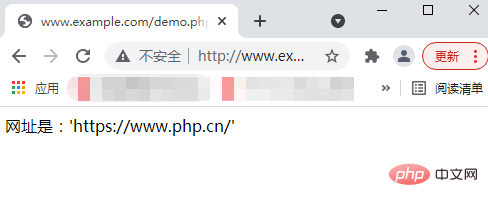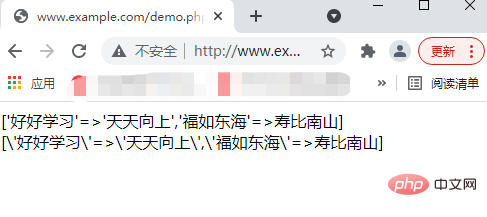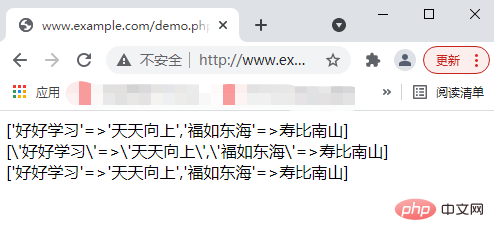Home >Backend Development >PHP Tutorial >Methods and restoration of escaped strings in PHP (detailed examples)
In the previous article "JSON Encoding and Decoding in PHP (Detailed Examples)" we introduced in detail the knowledge related to JSON encoding and decoding of arrays and strings in PHP. This article In this article, let’s take a look at the relevant knowledge of character escaping in PHP. I hope it will be helpful to everyone!

In the previous article we learned that PHP data can be processed through the json_encode() function and the json_decode() function Encoding and decoding, let's take a look at how to escape strings in PHP.
In PHP development projects, you can encounter many string escaping operations. How to escape strings at this time? In PHP, we can escape characters and Perform automatic escaping functions to operate. Let’s take a look at it together.
Escape characters - Manually escape strings
In the previous article, we introduced escape characters. Escape characters can Think of it as a special character that can perform escaping effects. Escape characters generally start with a backslash "\", followed by one or more characters. In this case, the escape character There is a meaning that can be escaped. Simply put, the escape character is treated as a special character constant.
Escape characters can convert ordinary characters into special purposes, and use these special purposes to convert characters into their original meaning.
If you want to use escape characters to convert a string, it should be noted that the string is defined using single quotes or double quotes. If there are characters in the string that can interfere with the definition of the string, At this time, we need to escape the possible interfering characters in the string, so as to avoid ambiguity in the definition of ego.
Next let’s look at escaping strings by escaping characters through an example. The example is as follows:
When we want to output: The URL is: 'https:// When m.sbmmt.com/', if you simply use echo to output a string, the characters in it may affect the final output result and cause errors. At this time, you can avoid this problem by using escape characters:
<?php
header("Content-type:text/html;charset=utf-8");
echo '网址是:\'//m.sbmmt.com/\'';
?>Output result:

#At this time, we escape the string through the escape character, so that we can output what we want The result was.
This kind of manual escaping is suitable for some simple strings. When the string is very complex, or the string is very long, it will be a bit troublesome to use escape characters for manual escaping. , is there any good solution?
addslashes() function and stripslashes() function are provided in PHP. The
<strong><span style="font-size: 20px;"></span>addslashes() </strong>Function - Automatically escape strings
The addslashes() function provided in PHP is used for automatic escaping. Through the addslashes() function, a backslash "\
addslashes(string)It should be noted that the parameter string represents the string that needs to be escaped, and the returned result is the character that has been escaped string. Let’s take a look at the use of this function through an example. The example is as follows:
<?php $str = "['好好学习'=>'天天向上','福如东海'=>寿比南山]"; echo $str . "<br>"; $a = addslashes($str); echo $a . "<br>"; ?>

<strong><span style="font-size: 20px;"></span>stripslashes()</strong> Function - Restore string
As we mentioned above, in PHP we can perform escape operations through the addslashes() function, that is, in the specified Add a backslash at the position, corresponding to the stripslashes() function, which is used to restore the string and delete the backslash added by the addslashes
stripslashes(string)It should be noted that the parameter string represents the string that needs to be operated, and the returned result is that the backslash has been deleted bar string. Next let’s take a look at the application of the stripslashes() function through an example. The example is as follows:
<?php $str = "['好好学习'=>'天天向上','福如东海'=>寿比南山]"; echo $str . "<br>"; $a = addslashes($str); echo $a . "<br>"; $b = stripslashes($a); echo $b . "<br>"; ?>

Through the above example, we use the stripslashes() function to restore the string escaped by the addslashes() function.
The escaping and restoration of strings can be completed through the addslashes() function and stripslashes() function.
If you are interested, you can click on "PHP Video Tutorial" to learn more about PHP knowledge.
The above is the detailed content of Methods and restoration of escaped strings in PHP (detailed examples). For more information, please follow other related articles on the PHP Chinese website!